Analysis of Retail Management in Australia: A Detailed Report
VerifiedAdded on 2022/10/06
|11
|2777
|4
Report
AI Summary
This report analyzes the Australian retail system, focusing on the historical development of department and discount stores. It defines these retail formats, discusses their merchandise offerings, and marketing strategies. The report explores the evolution of the Australian retail landscape, including c...
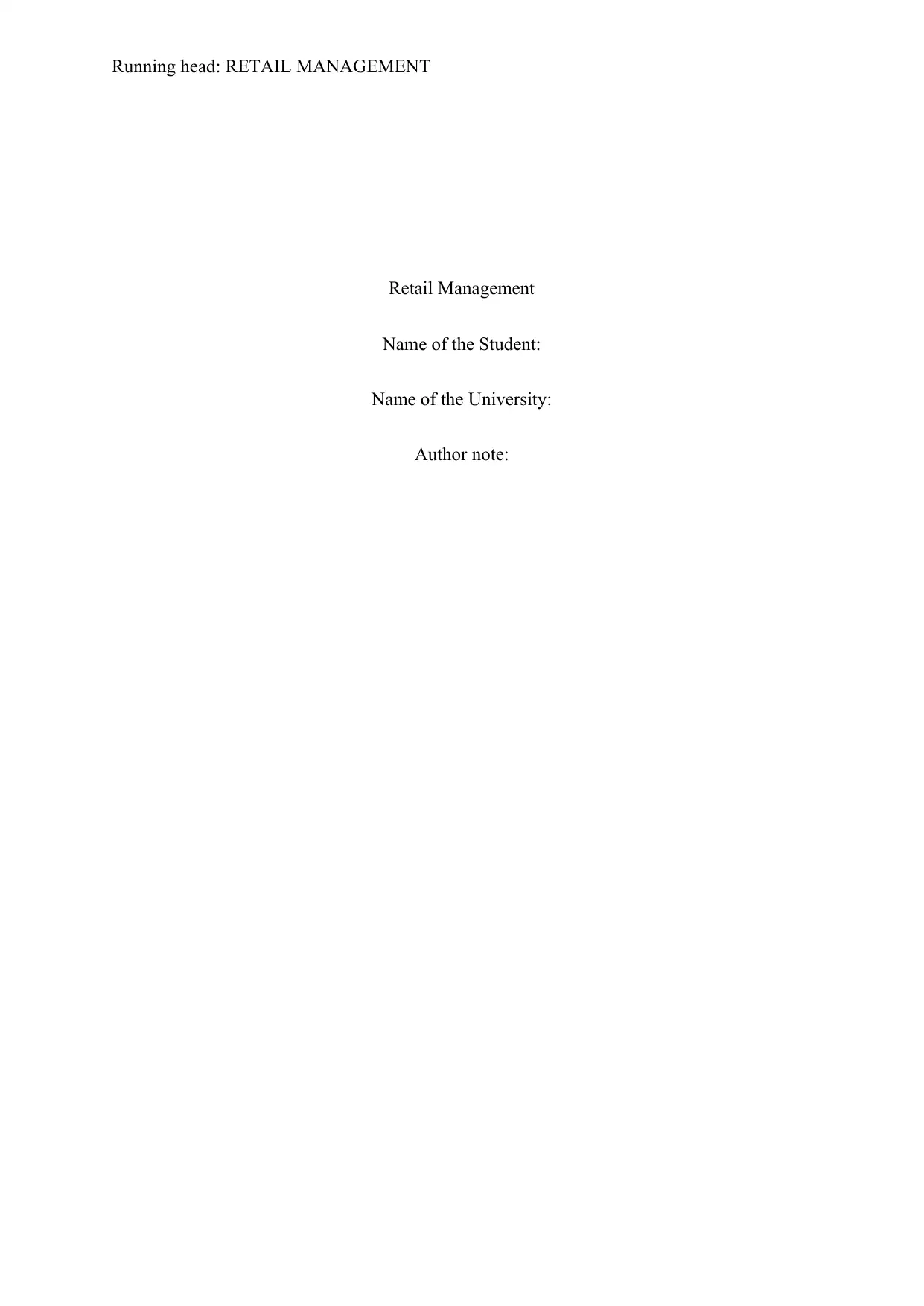
Running head: RETAIL MANAGEMENT
Retail Management
Name of the Student:
Name of the University:
Author note:
Retail Management
Name of the Student:
Name of the University:
Author note:
Paraphrase This Document
Need a fresh take? Get an instant paraphrase of this document with our AI Paraphraser
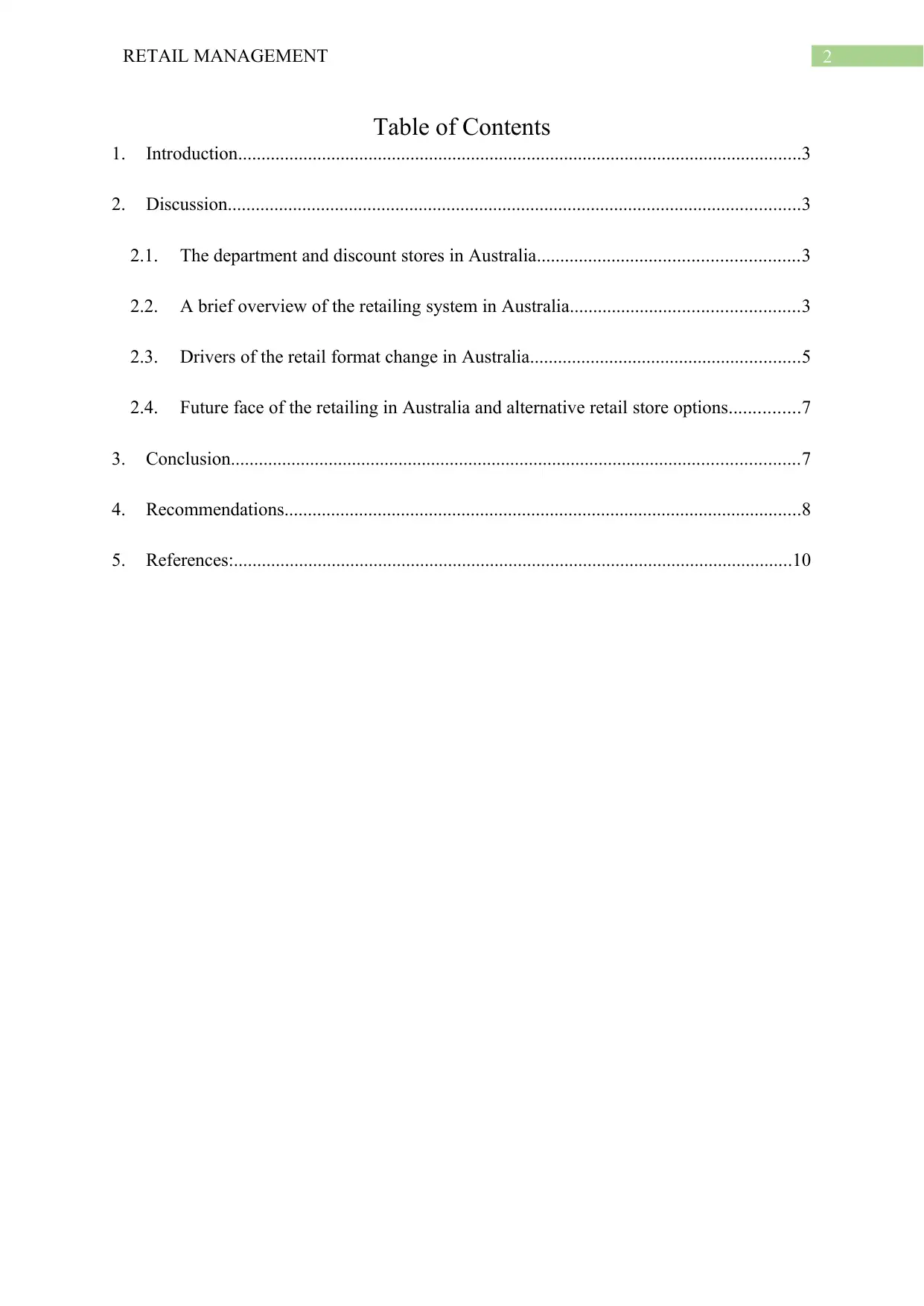
2RETAIL MANAGEMENT
Table of Contents
1. Introduction.........................................................................................................................3
2. Discussion...........................................................................................................................3
2.1. The department and discount stores in Australia........................................................3
2.2. A brief overview of the retailing system in Australia.................................................3
2.3. Drivers of the retail format change in Australia..........................................................5
2.4. Future face of the retailing in Australia and alternative retail store options...............7
3. Conclusion..........................................................................................................................7
4. Recommendations...............................................................................................................8
5. References:........................................................................................................................10
Table of Contents
1. Introduction.........................................................................................................................3
2. Discussion...........................................................................................................................3
2.1. The department and discount stores in Australia........................................................3
2.2. A brief overview of the retailing system in Australia.................................................3
2.3. Drivers of the retail format change in Australia..........................................................5
2.4. Future face of the retailing in Australia and alternative retail store options...............7
3. Conclusion..........................................................................................................................7
4. Recommendations...............................................................................................................8
5. References:........................................................................................................................10
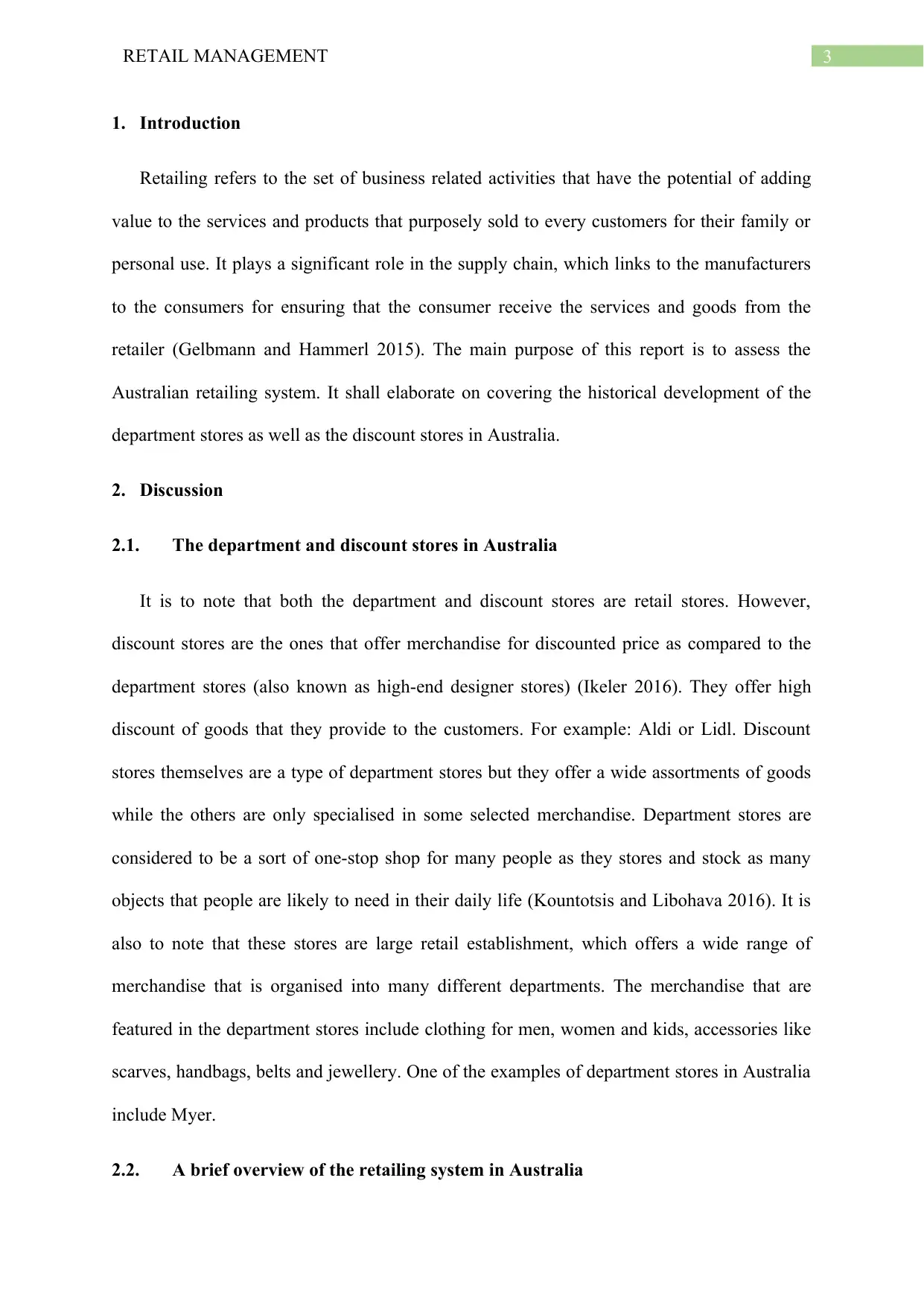
3RETAIL MANAGEMENT
1. Introduction
Retailing refers to the set of business related activities that have the potential of adding
value to the services and products that purposely sold to every customers for their family or
personal use. It plays a significant role in the supply chain, which links to the manufacturers
to the consumers for ensuring that the consumer receive the services and goods from the
retailer (Gelbmann and Hammerl 2015). The main purpose of this report is to assess the
Australian retailing system. It shall elaborate on covering the historical development of the
department stores as well as the discount stores in Australia.
2. Discussion
2.1. The department and discount stores in Australia
It is to note that both the department and discount stores are retail stores. However,
discount stores are the ones that offer merchandise for discounted price as compared to the
department stores (also known as high-end designer stores) (Ikeler 2016). They offer high
discount of goods that they provide to the customers. For example: Aldi or Lidl. Discount
stores themselves are a type of department stores but they offer a wide assortments of goods
while the others are only specialised in some selected merchandise. Department stores are
considered to be a sort of one-stop shop for many people as they stores and stock as many
objects that people are likely to need in their daily life (Kountotsis and Libohava 2016). It is
also to note that these stores are large retail establishment, which offers a wide range of
merchandise that is organised into many different departments. The merchandise that are
featured in the department stores include clothing for men, women and kids, accessories like
scarves, handbags, belts and jewellery. One of the examples of department stores in Australia
include Myer.
2.2. A brief overview of the retailing system in Australia
1. Introduction
Retailing refers to the set of business related activities that have the potential of adding
value to the services and products that purposely sold to every customers for their family or
personal use. It plays a significant role in the supply chain, which links to the manufacturers
to the consumers for ensuring that the consumer receive the services and goods from the
retailer (Gelbmann and Hammerl 2015). The main purpose of this report is to assess the
Australian retailing system. It shall elaborate on covering the historical development of the
department stores as well as the discount stores in Australia.
2. Discussion
2.1. The department and discount stores in Australia
It is to note that both the department and discount stores are retail stores. However,
discount stores are the ones that offer merchandise for discounted price as compared to the
department stores (also known as high-end designer stores) (Ikeler 2016). They offer high
discount of goods that they provide to the customers. For example: Aldi or Lidl. Discount
stores themselves are a type of department stores but they offer a wide assortments of goods
while the others are only specialised in some selected merchandise. Department stores are
considered to be a sort of one-stop shop for many people as they stores and stock as many
objects that people are likely to need in their daily life (Kountotsis and Libohava 2016). It is
also to note that these stores are large retail establishment, which offers a wide range of
merchandise that is organised into many different departments. The merchandise that are
featured in the department stores include clothing for men, women and kids, accessories like
scarves, handbags, belts and jewellery. One of the examples of department stores in Australia
include Myer.
2.2. A brief overview of the retailing system in Australia
You're viewing a preview
Unlock full access by subscribing today!
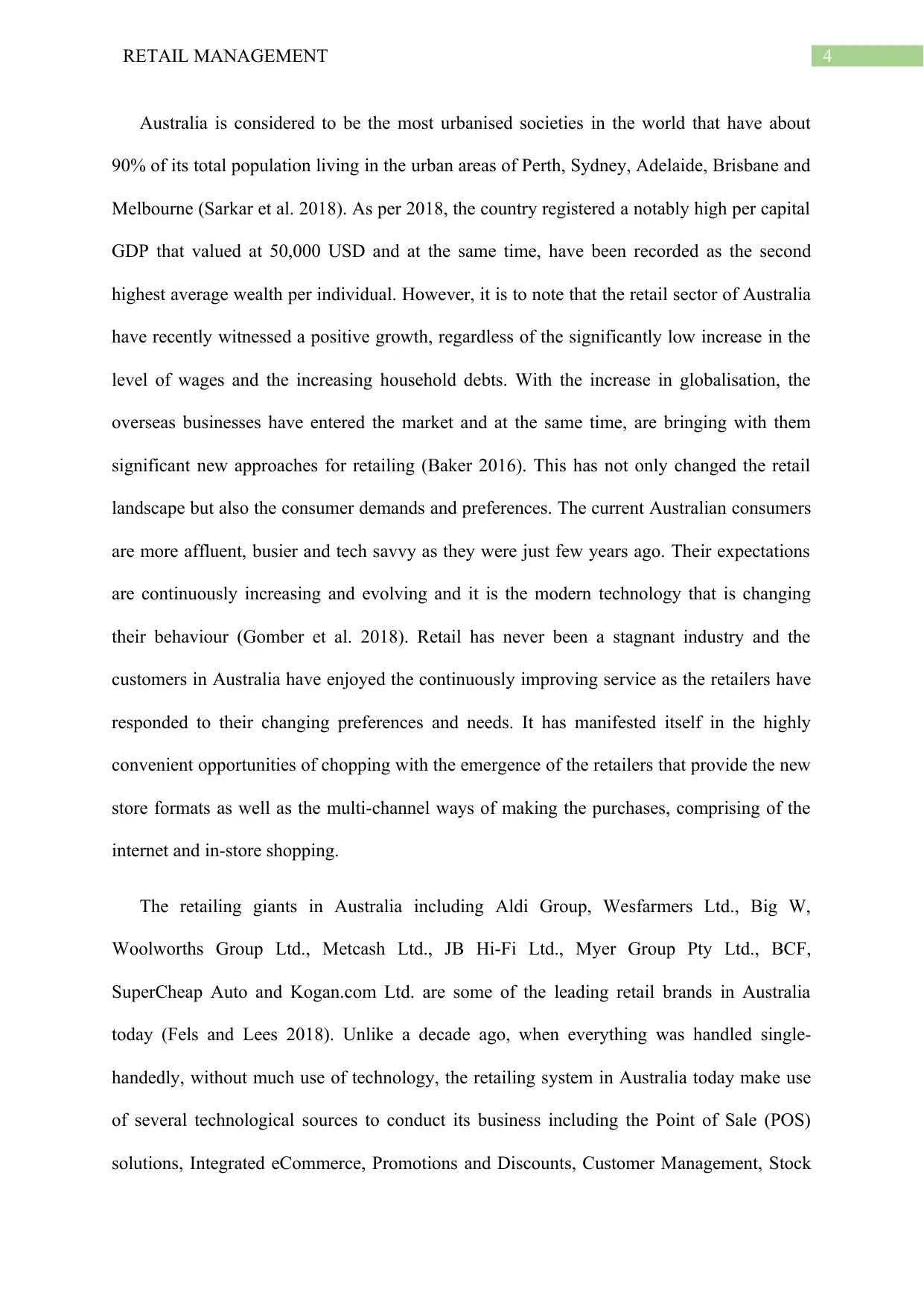
4RETAIL MANAGEMENT
Australia is considered to be the most urbanised societies in the world that have about
90% of its total population living in the urban areas of Perth, Sydney, Adelaide, Brisbane and
Melbourne (Sarkar et al. 2018). As per 2018, the country registered a notably high per capital
GDP that valued at 50,000 USD and at the same time, have been recorded as the second
highest average wealth per individual. However, it is to note that the retail sector of Australia
have recently witnessed a positive growth, regardless of the significantly low increase in the
level of wages and the increasing household debts. With the increase in globalisation, the
overseas businesses have entered the market and at the same time, are bringing with them
significant new approaches for retailing (Baker 2016). This has not only changed the retail
landscape but also the consumer demands and preferences. The current Australian consumers
are more affluent, busier and tech savvy as they were just few years ago. Their expectations
are continuously increasing and evolving and it is the modern technology that is changing
their behaviour (Gomber et al. 2018). Retail has never been a stagnant industry and the
customers in Australia have enjoyed the continuously improving service as the retailers have
responded to their changing preferences and needs. It has manifested itself in the highly
convenient opportunities of chopping with the emergence of the retailers that provide the new
store formats as well as the multi-channel ways of making the purchases, comprising of the
internet and in-store shopping.
The retailing giants in Australia including Aldi Group, Wesfarmers Ltd., Big W,
Woolworths Group Ltd., Metcash Ltd., JB Hi-Fi Ltd., Myer Group Pty Ltd., BCF,
SuperCheap Auto and Kogan.com Ltd. are some of the leading retail brands in Australia
today (Fels and Lees 2018). Unlike a decade ago, when everything was handled single-
handedly, without much use of technology, the retailing system in Australia today make use
of several technological sources to conduct its business including the Point of Sale (POS)
solutions, Integrated eCommerce, Promotions and Discounts, Customer Management, Stock
Australia is considered to be the most urbanised societies in the world that have about
90% of its total population living in the urban areas of Perth, Sydney, Adelaide, Brisbane and
Melbourne (Sarkar et al. 2018). As per 2018, the country registered a notably high per capital
GDP that valued at 50,000 USD and at the same time, have been recorded as the second
highest average wealth per individual. However, it is to note that the retail sector of Australia
have recently witnessed a positive growth, regardless of the significantly low increase in the
level of wages and the increasing household debts. With the increase in globalisation, the
overseas businesses have entered the market and at the same time, are bringing with them
significant new approaches for retailing (Baker 2016). This has not only changed the retail
landscape but also the consumer demands and preferences. The current Australian consumers
are more affluent, busier and tech savvy as they were just few years ago. Their expectations
are continuously increasing and evolving and it is the modern technology that is changing
their behaviour (Gomber et al. 2018). Retail has never been a stagnant industry and the
customers in Australia have enjoyed the continuously improving service as the retailers have
responded to their changing preferences and needs. It has manifested itself in the highly
convenient opportunities of chopping with the emergence of the retailers that provide the new
store formats as well as the multi-channel ways of making the purchases, comprising of the
internet and in-store shopping.
The retailing giants in Australia including Aldi Group, Wesfarmers Ltd., Big W,
Woolworths Group Ltd., Metcash Ltd., JB Hi-Fi Ltd., Myer Group Pty Ltd., BCF,
SuperCheap Auto and Kogan.com Ltd. are some of the leading retail brands in Australia
today (Fels and Lees 2018). Unlike a decade ago, when everything was handled single-
handedly, without much use of technology, the retailing system in Australia today make use
of several technological sources to conduct its business including the Point of Sale (POS)
solutions, Integrated eCommerce, Promotions and Discounts, Customer Management, Stock
Paraphrase This Document
Need a fresh take? Get an instant paraphrase of this document with our AI Paraphraser
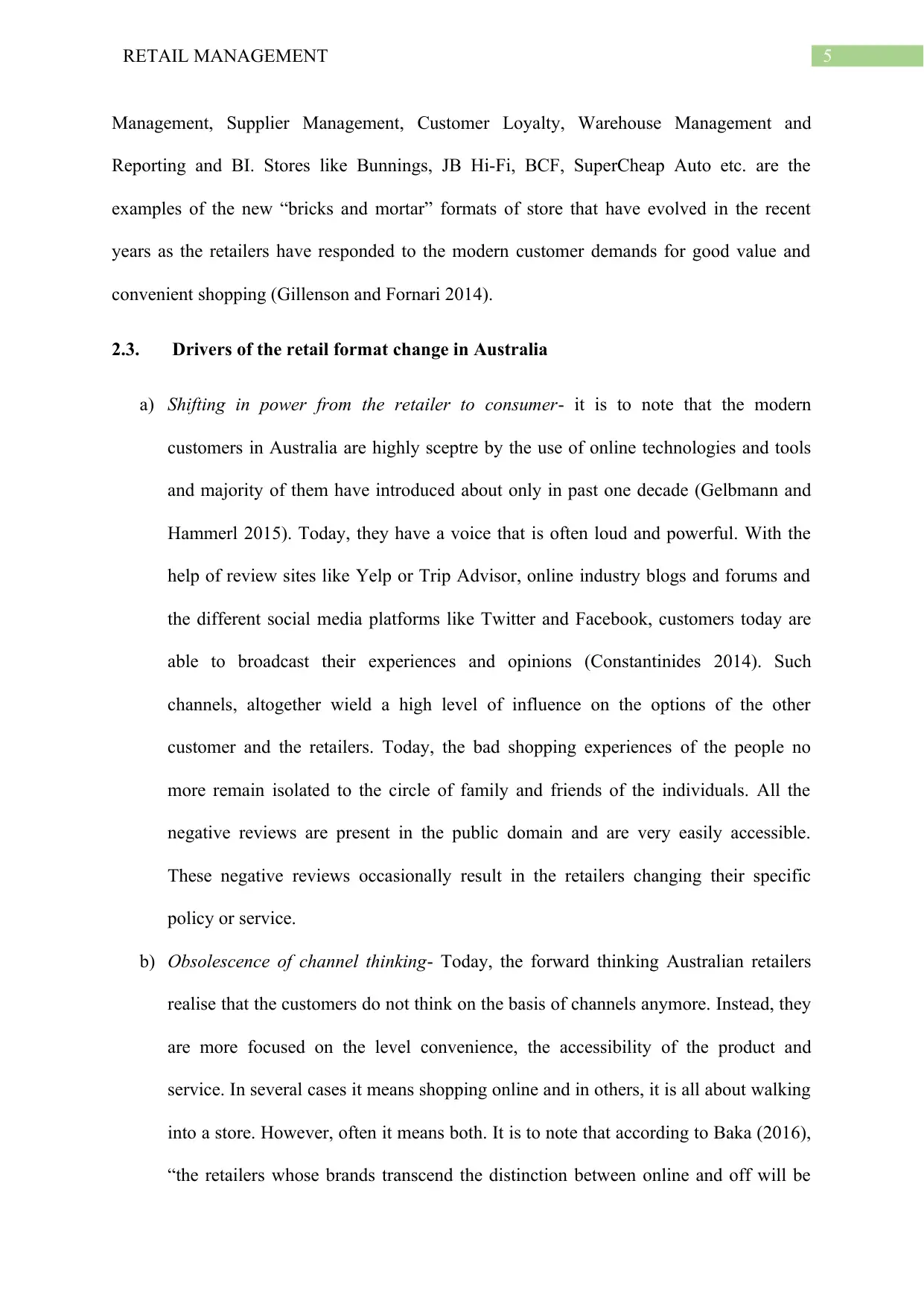
5RETAIL MANAGEMENT
Management, Supplier Management, Customer Loyalty, Warehouse Management and
Reporting and BI. Stores like Bunnings, JB Hi-Fi, BCF, SuperCheap Auto etc. are the
examples of the new “bricks and mortar” formats of store that have evolved in the recent
years as the retailers have responded to the modern customer demands for good value and
convenient shopping (Gillenson and Fornari 2014).
2.3. Drivers of the retail format change in Australia
a) Shifting in power from the retailer to consumer- it is to note that the modern
customers in Australia are highly sceptre by the use of online technologies and tools
and majority of them have introduced about only in past one decade (Gelbmann and
Hammerl 2015). Today, they have a voice that is often loud and powerful. With the
help of review sites like Yelp or Trip Advisor, online industry blogs and forums and
the different social media platforms like Twitter and Facebook, customers today are
able to broadcast their experiences and opinions (Constantinides 2014). Such
channels, altogether wield a high level of influence on the options of the other
customer and the retailers. Today, the bad shopping experiences of the people no
more remain isolated to the circle of family and friends of the individuals. All the
negative reviews are present in the public domain and are very easily accessible.
These negative reviews occasionally result in the retailers changing their specific
policy or service.
b) Obsolescence of channel thinking- Today, the forward thinking Australian retailers
realise that the customers do not think on the basis of channels anymore. Instead, they
are more focused on the level convenience, the accessibility of the product and
service. In several cases it means shopping online and in others, it is all about walking
into a store. However, often it means both. It is to note that according to Baka (2016),
“the retailers whose brands transcend the distinction between online and off will be
Management, Supplier Management, Customer Loyalty, Warehouse Management and
Reporting and BI. Stores like Bunnings, JB Hi-Fi, BCF, SuperCheap Auto etc. are the
examples of the new “bricks and mortar” formats of store that have evolved in the recent
years as the retailers have responded to the modern customer demands for good value and
convenient shopping (Gillenson and Fornari 2014).
2.3. Drivers of the retail format change in Australia
a) Shifting in power from the retailer to consumer- it is to note that the modern
customers in Australia are highly sceptre by the use of online technologies and tools
and majority of them have introduced about only in past one decade (Gelbmann and
Hammerl 2015). Today, they have a voice that is often loud and powerful. With the
help of review sites like Yelp or Trip Advisor, online industry blogs and forums and
the different social media platforms like Twitter and Facebook, customers today are
able to broadcast their experiences and opinions (Constantinides 2014). Such
channels, altogether wield a high level of influence on the options of the other
customer and the retailers. Today, the bad shopping experiences of the people no
more remain isolated to the circle of family and friends of the individuals. All the
negative reviews are present in the public domain and are very easily accessible.
These negative reviews occasionally result in the retailers changing their specific
policy or service.
b) Obsolescence of channel thinking- Today, the forward thinking Australian retailers
realise that the customers do not think on the basis of channels anymore. Instead, they
are more focused on the level convenience, the accessibility of the product and
service. In several cases it means shopping online and in others, it is all about walking
into a store. However, often it means both. It is to note that according to Baka (2016),
“the retailers whose brands transcend the distinction between online and off will be

6RETAIL MANAGEMENT
the ones that consumers think of more frequently, recognize more readily, and shop at
more loyally”.
Such a change in the channel thinking of the customers is the outcome of the
ever increasing immersion and technological awareness on the parts of the customers
or shoppers, particularly in terms of their immediate access to the web with the help
of their cell phones. Also it is to mention that the tablets and the smartphones have
given the customers complete access to the online details and data around the clock,
be it in the interest of the show rooming or in the more current event of web rooming.
Combining all these practices with the personalisation of the shopping experience has
made the mobile commerce feasibly the one and only most guiding driver of the
change in the retail environment and market in Australia.
c) The increasing velocity and volume of the retail data- it is also to note that there is
more and more number of retailers that are using a cohesive and robust strategy in the
management and data analytics. Right from ensuring a more effective supply chain to
the streamlining of the operations of the store and the engaging customers as well as
building loyalty, data is always at the core of the retail operation today in majority of
the retail stores all across Australia (Bianchi, Drennan and Proud 2014). Along with
this demand has come the notion of increase in the power, level of complexity and the
volume of the applications and data sources.
However, there are several challenges that are influencing this driving force
for the retail change, which are way more technically complex as compared to the
above mentioned two drivers. One among such challenges starts from the usage of the
disjointed systems that are not meant for working together- the disparate data. One of
the other concerns that need for getting the right data to the right decision maker at
the ones that consumers think of more frequently, recognize more readily, and shop at
more loyally”.
Such a change in the channel thinking of the customers is the outcome of the
ever increasing immersion and technological awareness on the parts of the customers
or shoppers, particularly in terms of their immediate access to the web with the help
of their cell phones. Also it is to mention that the tablets and the smartphones have
given the customers complete access to the online details and data around the clock,
be it in the interest of the show rooming or in the more current event of web rooming.
Combining all these practices with the personalisation of the shopping experience has
made the mobile commerce feasibly the one and only most guiding driver of the
change in the retail environment and market in Australia.
c) The increasing velocity and volume of the retail data- it is also to note that there is
more and more number of retailers that are using a cohesive and robust strategy in the
management and data analytics. Right from ensuring a more effective supply chain to
the streamlining of the operations of the store and the engaging customers as well as
building loyalty, data is always at the core of the retail operation today in majority of
the retail stores all across Australia (Bianchi, Drennan and Proud 2014). Along with
this demand has come the notion of increase in the power, level of complexity and the
volume of the applications and data sources.
However, there are several challenges that are influencing this driving force
for the retail change, which are way more technically complex as compared to the
above mentioned two drivers. One among such challenges starts from the usage of the
disjointed systems that are not meant for working together- the disparate data. One of
the other concerns that need for getting the right data to the right decision maker at
You're viewing a preview
Unlock full access by subscribing today!
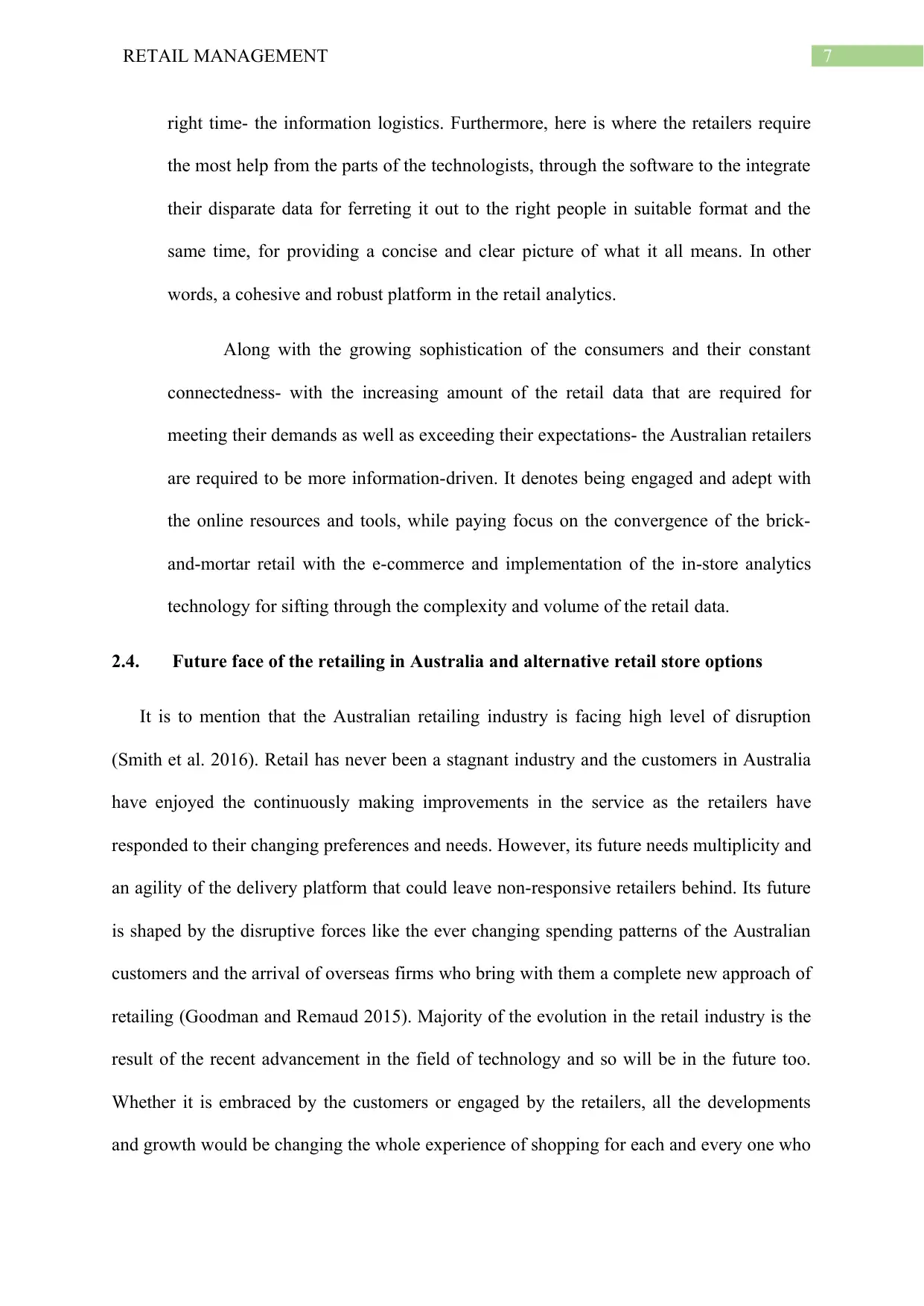
7RETAIL MANAGEMENT
right time- the information logistics. Furthermore, here is where the retailers require
the most help from the parts of the technologists, through the software to the integrate
their disparate data for ferreting it out to the right people in suitable format and the
same time, for providing a concise and clear picture of what it all means. In other
words, a cohesive and robust platform in the retail analytics.
Along with the growing sophistication of the consumers and their constant
connectedness- with the increasing amount of the retail data that are required for
meeting their demands as well as exceeding their expectations- the Australian retailers
are required to be more information-driven. It denotes being engaged and adept with
the online resources and tools, while paying focus on the convergence of the brick-
and-mortar retail with the e-commerce and implementation of the in-store analytics
technology for sifting through the complexity and volume of the retail data.
2.4. Future face of the retailing in Australia and alternative retail store options
It is to mention that the Australian retailing industry is facing high level of disruption
(Smith et al. 2016). Retail has never been a stagnant industry and the customers in Australia
have enjoyed the continuously making improvements in the service as the retailers have
responded to their changing preferences and needs. However, its future needs multiplicity and
an agility of the delivery platform that could leave non-responsive retailers behind. Its future
is shaped by the disruptive forces like the ever changing spending patterns of the Australian
customers and the arrival of overseas firms who bring with them a complete new approach of
retailing (Goodman and Remaud 2015). Majority of the evolution in the retail industry is the
result of the recent advancement in the field of technology and so will be in the future too.
Whether it is embraced by the customers or engaged by the retailers, all the developments
and growth would be changing the whole experience of shopping for each and every one who
right time- the information logistics. Furthermore, here is where the retailers require
the most help from the parts of the technologists, through the software to the integrate
their disparate data for ferreting it out to the right people in suitable format and the
same time, for providing a concise and clear picture of what it all means. In other
words, a cohesive and robust platform in the retail analytics.
Along with the growing sophistication of the consumers and their constant
connectedness- with the increasing amount of the retail data that are required for
meeting their demands as well as exceeding their expectations- the Australian retailers
are required to be more information-driven. It denotes being engaged and adept with
the online resources and tools, while paying focus on the convergence of the brick-
and-mortar retail with the e-commerce and implementation of the in-store analytics
technology for sifting through the complexity and volume of the retail data.
2.4. Future face of the retailing in Australia and alternative retail store options
It is to mention that the Australian retailing industry is facing high level of disruption
(Smith et al. 2016). Retail has never been a stagnant industry and the customers in Australia
have enjoyed the continuously making improvements in the service as the retailers have
responded to their changing preferences and needs. However, its future needs multiplicity and
an agility of the delivery platform that could leave non-responsive retailers behind. Its future
is shaped by the disruptive forces like the ever changing spending patterns of the Australian
customers and the arrival of overseas firms who bring with them a complete new approach of
retailing (Goodman and Remaud 2015). Majority of the evolution in the retail industry is the
result of the recent advancement in the field of technology and so will be in the future too.
Whether it is embraced by the customers or engaged by the retailers, all the developments
and growth would be changing the whole experience of shopping for each and every one who
Paraphrase This Document
Need a fresh take? Get an instant paraphrase of this document with our AI Paraphraser
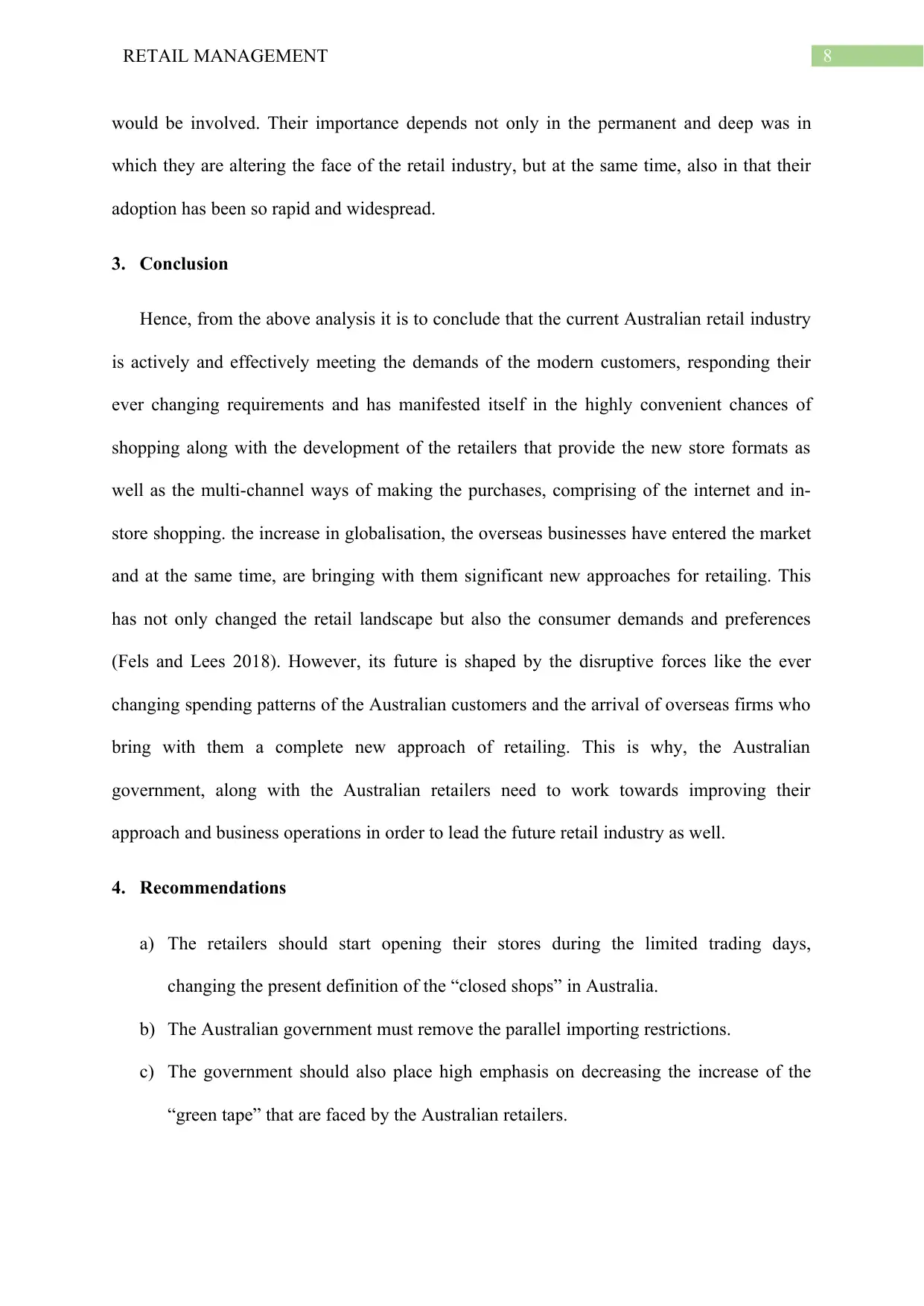
8RETAIL MANAGEMENT
would be involved. Their importance depends not only in the permanent and deep was in
which they are altering the face of the retail industry, but at the same time, also in that their
adoption has been so rapid and widespread.
3. Conclusion
Hence, from the above analysis it is to conclude that the current Australian retail industry
is actively and effectively meeting the demands of the modern customers, responding their
ever changing requirements and has manifested itself in the highly convenient chances of
shopping along with the development of the retailers that provide the new store formats as
well as the multi-channel ways of making the purchases, comprising of the internet and in-
store shopping. the increase in globalisation, the overseas businesses have entered the market
and at the same time, are bringing with them significant new approaches for retailing. This
has not only changed the retail landscape but also the consumer demands and preferences
(Fels and Lees 2018). However, its future is shaped by the disruptive forces like the ever
changing spending patterns of the Australian customers and the arrival of overseas firms who
bring with them a complete new approach of retailing. This is why, the Australian
government, along with the Australian retailers need to work towards improving their
approach and business operations in order to lead the future retail industry as well.
4. Recommendations
a) The retailers should start opening their stores during the limited trading days,
changing the present definition of the “closed shops” in Australia.
b) The Australian government must remove the parallel importing restrictions.
c) The government should also place high emphasis on decreasing the increase of the
“green tape” that are faced by the Australian retailers.
would be involved. Their importance depends not only in the permanent and deep was in
which they are altering the face of the retail industry, but at the same time, also in that their
adoption has been so rapid and widespread.
3. Conclusion
Hence, from the above analysis it is to conclude that the current Australian retail industry
is actively and effectively meeting the demands of the modern customers, responding their
ever changing requirements and has manifested itself in the highly convenient chances of
shopping along with the development of the retailers that provide the new store formats as
well as the multi-channel ways of making the purchases, comprising of the internet and in-
store shopping. the increase in globalisation, the overseas businesses have entered the market
and at the same time, are bringing with them significant new approaches for retailing. This
has not only changed the retail landscape but also the consumer demands and preferences
(Fels and Lees 2018). However, its future is shaped by the disruptive forces like the ever
changing spending patterns of the Australian customers and the arrival of overseas firms who
bring with them a complete new approach of retailing. This is why, the Australian
government, along with the Australian retailers need to work towards improving their
approach and business operations in order to lead the future retail industry as well.
4. Recommendations
a) The retailers should start opening their stores during the limited trading days,
changing the present definition of the “closed shops” in Australia.
b) The Australian government must remove the parallel importing restrictions.
c) The government should also place high emphasis on decreasing the increase of the
“green tape” that are faced by the Australian retailers.
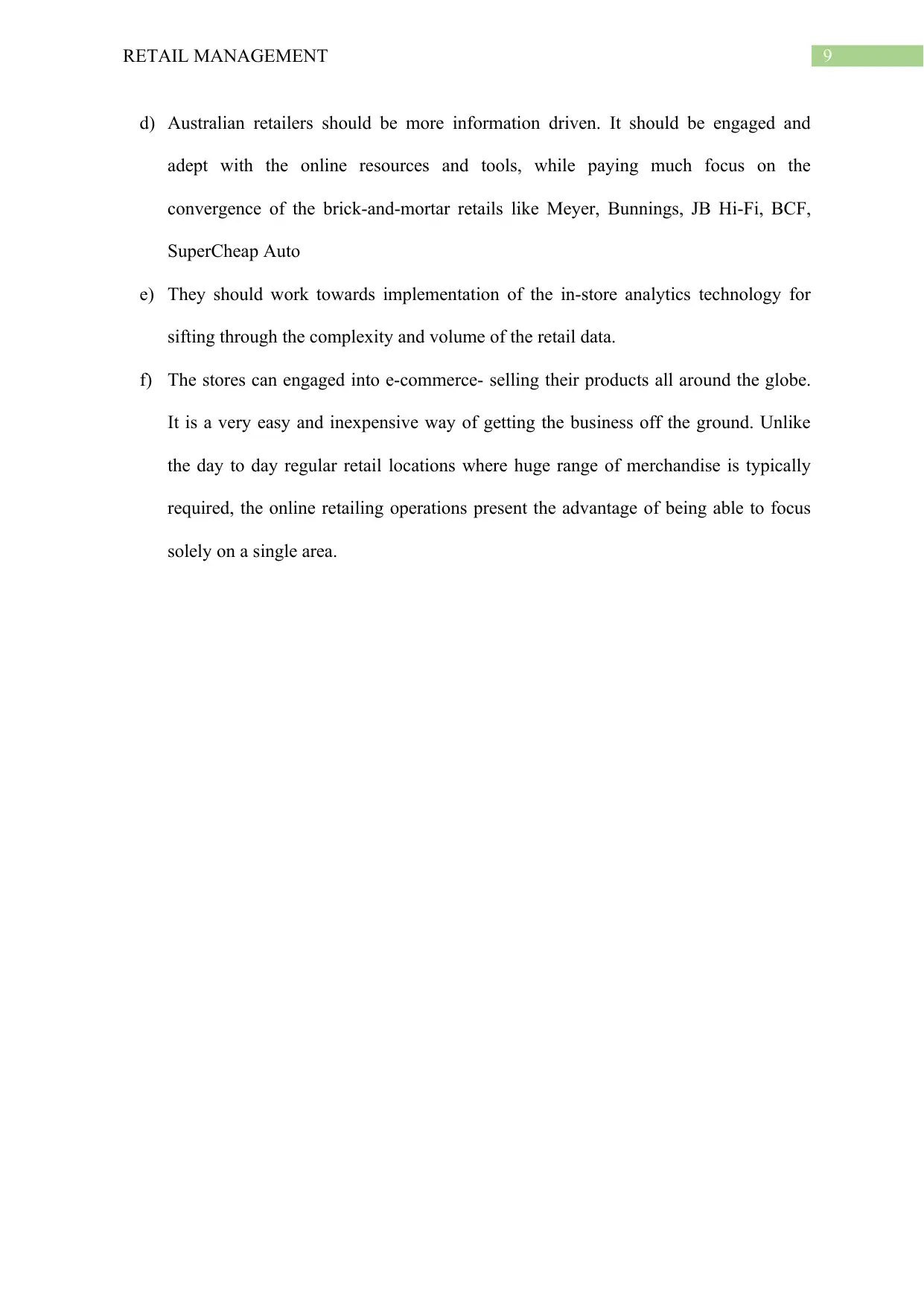
9RETAIL MANAGEMENT
d) Australian retailers should be more information driven. It should be engaged and
adept with the online resources and tools, while paying much focus on the
convergence of the brick-and-mortar retails like Meyer, Bunnings, JB Hi-Fi, BCF,
SuperCheap Auto
e) They should work towards implementation of the in-store analytics technology for
sifting through the complexity and volume of the retail data.
f) The stores can engaged into e-commerce- selling their products all around the globe.
It is a very easy and inexpensive way of getting the business off the ground. Unlike
the day to day regular retail locations where huge range of merchandise is typically
required, the online retailing operations present the advantage of being able to focus
solely on a single area.
d) Australian retailers should be more information driven. It should be engaged and
adept with the online resources and tools, while paying much focus on the
convergence of the brick-and-mortar retails like Meyer, Bunnings, JB Hi-Fi, BCF,
SuperCheap Auto
e) They should work towards implementation of the in-store analytics technology for
sifting through the complexity and volume of the retail data.
f) The stores can engaged into e-commerce- selling their products all around the globe.
It is a very easy and inexpensive way of getting the business off the ground. Unlike
the day to day regular retail locations where huge range of merchandise is typically
required, the online retailing operations present the advantage of being able to focus
solely on a single area.
You're viewing a preview
Unlock full access by subscribing today!
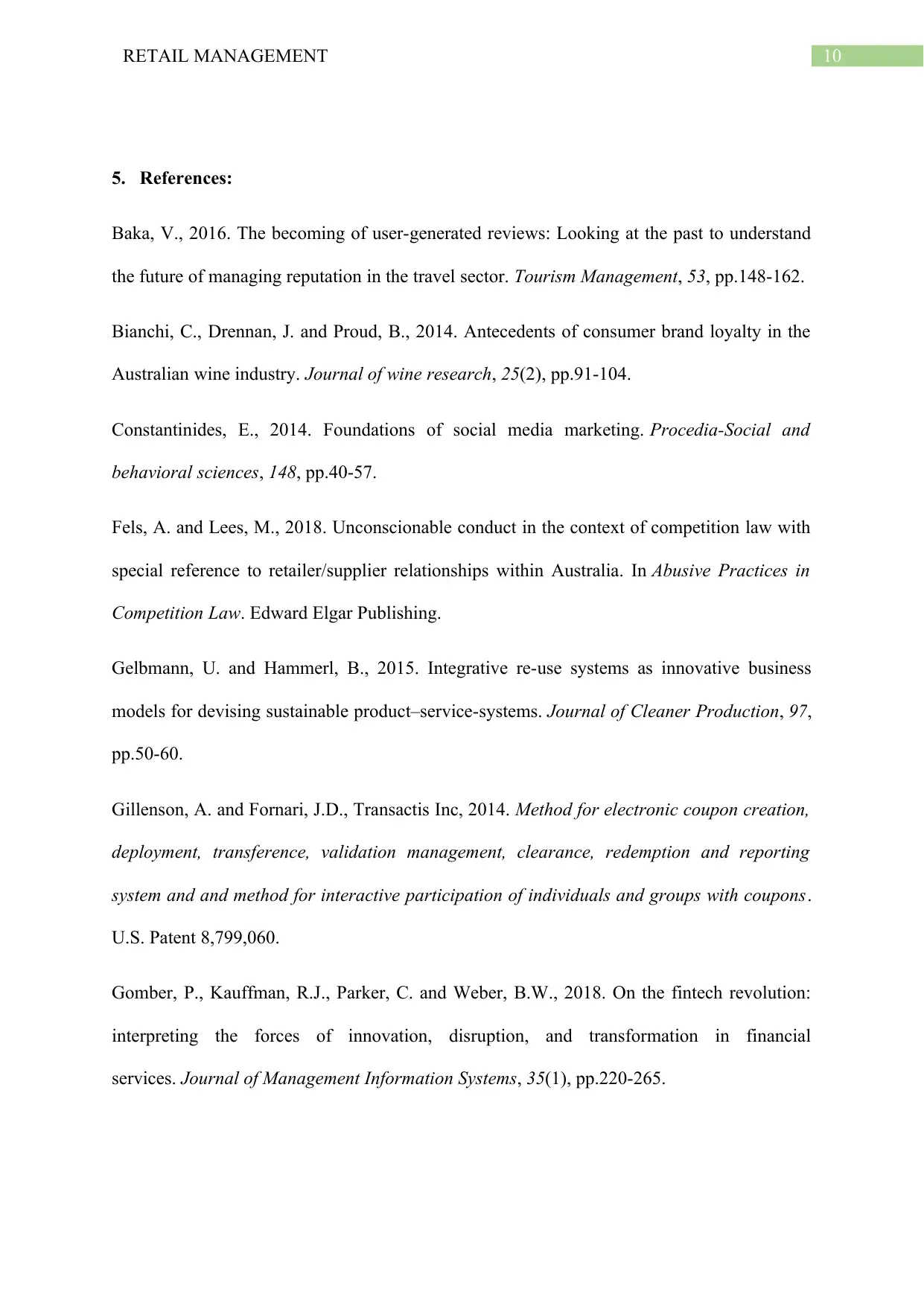
10RETAIL MANAGEMENT
5. References:
Baka, V., 2016. The becoming of user-generated reviews: Looking at the past to understand
the future of managing reputation in the travel sector. Tourism Management, 53, pp.148-162.
Bianchi, C., Drennan, J. and Proud, B., 2014. Antecedents of consumer brand loyalty in the
Australian wine industry. Journal of wine research, 25(2), pp.91-104.
Constantinides, E., 2014. Foundations of social media marketing. Procedia-Social and
behavioral sciences, 148, pp.40-57.
Fels, A. and Lees, M., 2018. Unconscionable conduct in the context of competition law with
special reference to retailer/supplier relationships within Australia. In Abusive Practices in
Competition Law. Edward Elgar Publishing.
Gelbmann, U. and Hammerl, B., 2015. Integrative re-use systems as innovative business
models for devising sustainable product–service-systems. Journal of Cleaner Production, 97,
pp.50-60.
Gillenson, A. and Fornari, J.D., Transactis Inc, 2014. Method for electronic coupon creation,
deployment, transference, validation management, clearance, redemption and reporting
system and and method for interactive participation of individuals and groups with coupons.
U.S. Patent 8,799,060.
Gomber, P., Kauffman, R.J., Parker, C. and Weber, B.W., 2018. On the fintech revolution:
interpreting the forces of innovation, disruption, and transformation in financial
services. Journal of Management Information Systems, 35(1), pp.220-265.
5. References:
Baka, V., 2016. The becoming of user-generated reviews: Looking at the past to understand
the future of managing reputation in the travel sector. Tourism Management, 53, pp.148-162.
Bianchi, C., Drennan, J. and Proud, B., 2014. Antecedents of consumer brand loyalty in the
Australian wine industry. Journal of wine research, 25(2), pp.91-104.
Constantinides, E., 2014. Foundations of social media marketing. Procedia-Social and
behavioral sciences, 148, pp.40-57.
Fels, A. and Lees, M., 2018. Unconscionable conduct in the context of competition law with
special reference to retailer/supplier relationships within Australia. In Abusive Practices in
Competition Law. Edward Elgar Publishing.
Gelbmann, U. and Hammerl, B., 2015. Integrative re-use systems as innovative business
models for devising sustainable product–service-systems. Journal of Cleaner Production, 97,
pp.50-60.
Gillenson, A. and Fornari, J.D., Transactis Inc, 2014. Method for electronic coupon creation,
deployment, transference, validation management, clearance, redemption and reporting
system and and method for interactive participation of individuals and groups with coupons.
U.S. Patent 8,799,060.
Gomber, P., Kauffman, R.J., Parker, C. and Weber, B.W., 2018. On the fintech revolution:
interpreting the forces of innovation, disruption, and transformation in financial
services. Journal of Management Information Systems, 35(1), pp.220-265.
Paraphrase This Document
Need a fresh take? Get an instant paraphrase of this document with our AI Paraphraser
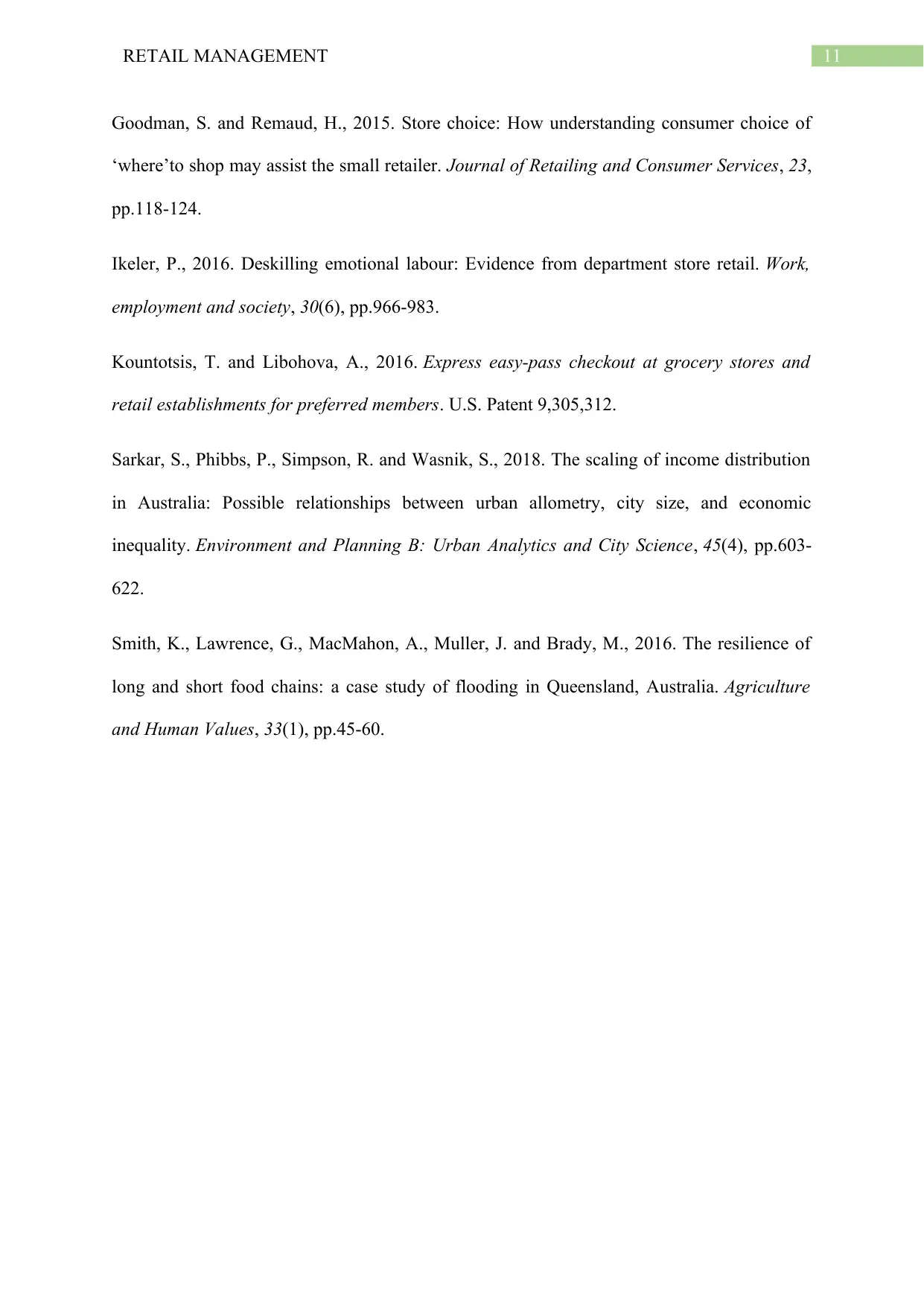
11RETAIL MANAGEMENT
Goodman, S. and Remaud, H., 2015. Store choice: How understanding consumer choice of
‘where’to shop may assist the small retailer. Journal of Retailing and Consumer Services, 23,
pp.118-124.
Ikeler, P., 2016. Deskilling emotional labour: Evidence from department store retail. Work,
employment and society, 30(6), pp.966-983.
Kountotsis, T. and Libohova, A., 2016. Express easy-pass checkout at grocery stores and
retail establishments for preferred members. U.S. Patent 9,305,312.
Sarkar, S., Phibbs, P., Simpson, R. and Wasnik, S., 2018. The scaling of income distribution
in Australia: Possible relationships between urban allometry, city size, and economic
inequality. Environment and Planning B: Urban Analytics and City Science, 45(4), pp.603-
622.
Smith, K., Lawrence, G., MacMahon, A., Muller, J. and Brady, M., 2016. The resilience of
long and short food chains: a case study of flooding in Queensland, Australia. Agriculture
and Human Values, 33(1), pp.45-60.
Goodman, S. and Remaud, H., 2015. Store choice: How understanding consumer choice of
‘where’to shop may assist the small retailer. Journal of Retailing and Consumer Services, 23,
pp.118-124.
Ikeler, P., 2016. Deskilling emotional labour: Evidence from department store retail. Work,
employment and society, 30(6), pp.966-983.
Kountotsis, T. and Libohova, A., 2016. Express easy-pass checkout at grocery stores and
retail establishments for preferred members. U.S. Patent 9,305,312.
Sarkar, S., Phibbs, P., Simpson, R. and Wasnik, S., 2018. The scaling of income distribution
in Australia: Possible relationships between urban allometry, city size, and economic
inequality. Environment and Planning B: Urban Analytics and City Science, 45(4), pp.603-
622.
Smith, K., Lawrence, G., MacMahon, A., Muller, J. and Brady, M., 2016. The resilience of
long and short food chains: a case study of flooding in Queensland, Australia. Agriculture
and Human Values, 33(1), pp.45-60.
1 out of 11
Related Documents
Your All-in-One AI-Powered Toolkit for Academic Success.
+13062052269
info@desklib.com
Available 24*7 on WhatsApp / Email
![[object Object]](/_next/static/media/star-bottom.7253800d.svg)
Unlock your academic potential
© 2024 | Zucol Services PVT LTD | All rights reserved.



